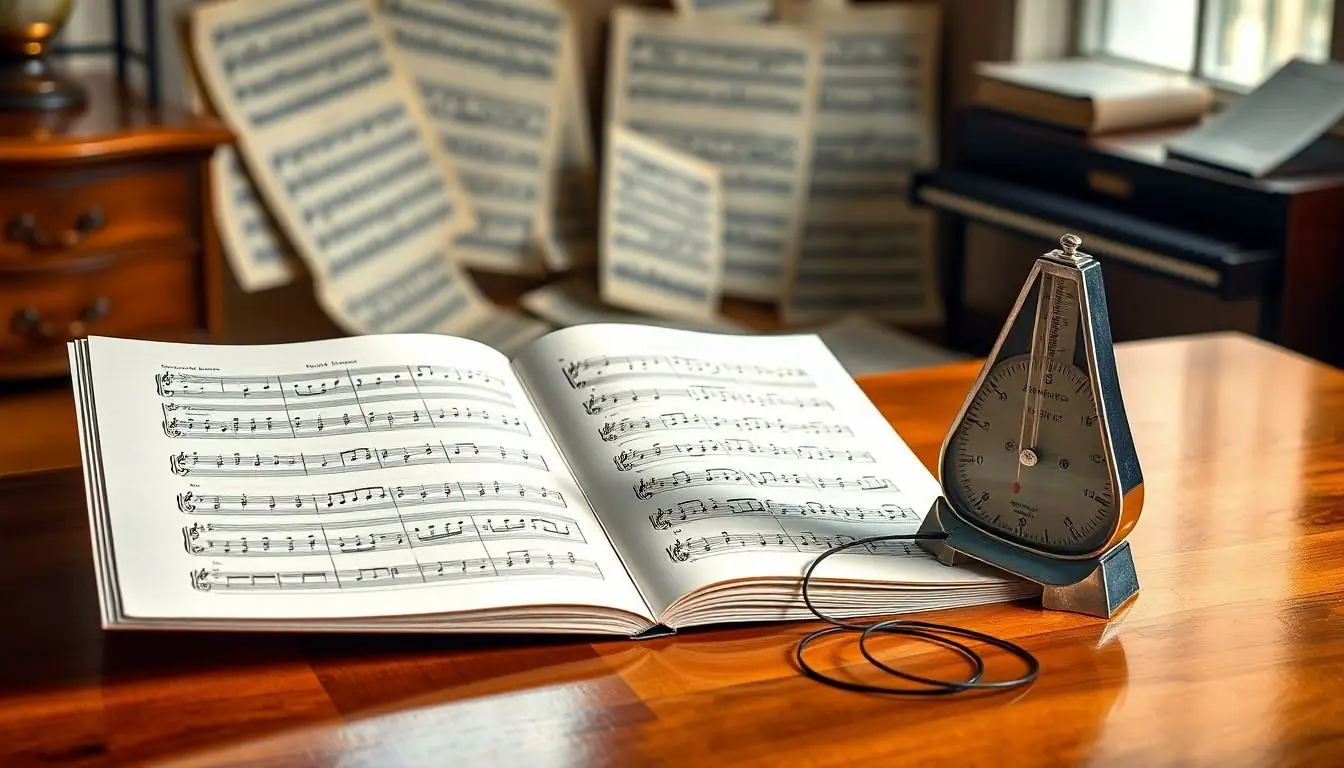Table of Contents
ToggleIn the world of classical music, the term “op” pops up more often than a surprise encore at a concert. But what does it really mean? For those who’ve ever scratched their heads while flipping through a program, it stands for “opus,” a fancy Latin word meaning “work.” Think of it as a musical badge of honor, giving each composition its own unique identity.
Understanding Musical Terminology
The term “opus” serves as a crucial element in classical music terminology. It simplifies identifying a specific musical work. Traditionally, composers assign opus numbers to their compositions, which helps organize their catalog.
Classical music features works categorized by these numbers, often in chronological order of composition. Notably, the first composition by a composer may carry the opus number one. As composers create more works, subsequent pieces receive higher numbers.
In addition to opus numbers, composers sometimes use a more complex system to categorize their works, such as “Op.” followed by a specific number. This designation provides context about the piece’s placement within the overall oeuvre of the composer.
Different composers adopt varying approaches to opus numbering. For instance, Beethoven’s creations are distinctively famous due to their opus designations. Some composers, like J.S. Bach, used other classification systems such as BWV (Bach Werke Verzeichnis) to identify their works instead of opus numbers.
Musicians find opus numbers beneficial when searching for specific pieces. These identifiers create ease in referencing compositions, supporting both performers and scholars in their pursuits. By understanding the significance of opus numbers, audiences can appreciate the organization behind classical music’s vast repertoire.
Such terminology enriches discussions within classical music communities. Familiarity with terms like “opus” fosters deeper engagement with the music itself and encourages exploration of lesser-known compositions.
What Does Op Mean in Classical Music?

In classical music, “op” stands for “opus,” a Latin term meaning “work.” This term designates each musical composition, effectively identifying unique pieces within a composer’s repertoire.
The Definition of Opus
An opus represents a specific musical work created by a composer. It often includes various forms, such as symphonies, concertos, and chamber works. Each opus is numbered sequentially, allowing listeners and musicians to navigate a composer’s creations easily. For instance, Beethoven’s first symphony holds the opus number 21, while his late piano sonatas receive higher designations. This systematic numbering enhances organizational clarity within classical music catalogs, promoting efficient recognition of individual works.
Historical Context of Opus Numbers
Opus numbers emerged in the 18th century as composers sought to catalog their works systematically. Various composers adopted this practice, contributing to its widespread use. While some composers, like Beethoven, assigned opus numbers chronologically, others, like J.S. Bach, opted for different systems such as the BWV catalog. Over time, opus numbers have become fundamental in classical music, aiding performers and scholars in referencing music accurately. Consequently, understanding opus designations fosters appreciation for the diversity and richness of musical compositions.
The Importance of Opus Numbers in Compositions
Opus numbers serve an essential role in classical music. They provide a systematic method for identifying and organizing compositions, simplifying the search for works by specific composers.
How Opus Numbers Are Assigned
Composers typically assign opus numbers chronologically. They label their works as they create them, distinguishing earlier pieces from later ones. Variability exists; some may use numbers based on individual cataloging methods. For instance, Claude Debussy often preferred a different numbering format, while Franz Schubert’s output is organized using the D number system. Opus numbers can reflect the sequence of a composer’s output, offering insight into their development and style over time.
Examples of Famous Compositions and Their Opus Numbers
Numerous renowned pieces highlight the significance of opus numbers. Beethoven’s “Symphony No. 1” is cataloged as Op. 21. His “Moonlight Sonata,” formally titled “Piano Sonata No. 14,” corresponds to Op. 27, No. 2. Another notable example includes Chopin’s “Nocturne in E-flat major,” which is identified as Op. 9, No. 2. These examples underscore how opus numbers link compositions to their creators and historical context. They further aid musicians and scholars in navigating the vast landscape of classical works.
Variations and Alternatives to Op Numbers
Some composers utilize alternate systems for cataloging their works. For instance, J.S. Bach employed the BWV (Bach Werke Verzeichnis) system, which organizes his compositions by genre and chronology. This system doesn’t use opus numbers; instead, it assigns a unique BWV number to each work, such as BWV 1007 for his “Cello Suite No. 1.”
Another example includes Claude Debussy. He used a cataloging system that features “D” numbers to designate his compositions. This method, like the BWV system, helps identify various works outside the traditional opus framework. Debussy’s “Clair de Lune,” for instance, is referred to as “Suite Bergamasque, L. 75.”
Franz Schubert took a similar approach. His works are often labeled with “D” numbers from the catalog created by Otto Erich Deutsch. Schubert’s famous “Symphony No. 8,” frequently called the “Unfinished Symphony,” corresponds to D. 759.
Modern composers and music theorists may also explore unconventional methods for identifying works. Systems based on thematic cataloging or even numerical designations are sometimes adopted, allowing for flexibility in organization. These alternatives offer innovative ways to document compositions and can adapt to individual preferences.
Merging these various systems provides musicians and scholars with diverse tools for locating and referencing compositions. Each cataloging approach contributes uniquely to the understanding of classical music. Such diversity in identifying works enriches the landscape, fostering deeper connections between artists, their pieces, and the historical context surrounding them.
Opus numbers play a vital role in the world of classical music. They not only help in identifying and organizing compositions but also connect listeners to the rich history of the music. By understanding the significance of “op,” musicians and enthusiasts can appreciate the nuances of each piece and its place within the composer’s body of work. The variety of cataloging systems used by different composers adds depth to the exploration of their music. This knowledge fosters a greater appreciation for classical compositions and encourages a deeper engagement with the art form.





